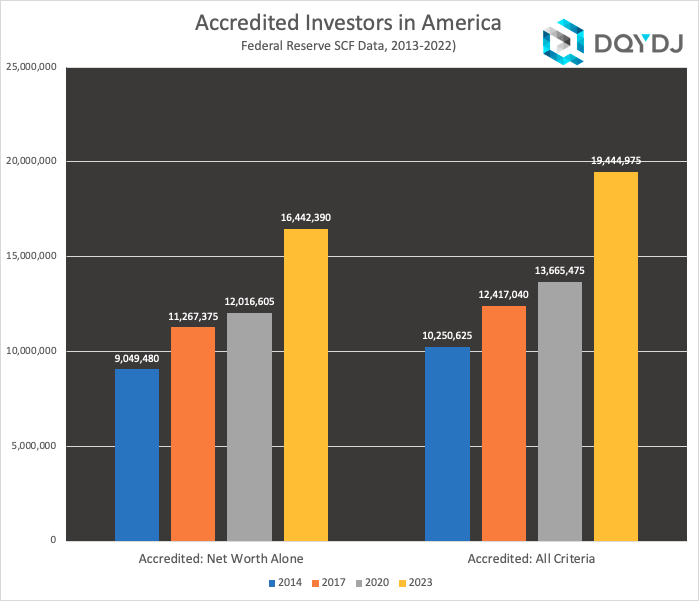We estimate in 2023 there were 19,444,975 accredited investor households in America. Roughly 14.8% of American Households qualified as Accredited Investors.
Those households controlled roughly $109.5 trillion in wealth in 2023. Measured by the SCF, that was around 78.7% of all private wealth in America.
(These estimates do not include professional certifications allowing accreditation, which do not factor in net worth or income. More discussion and methodology below.)
Accredited investors in the United States: nearly 15% of households
In the 2022 Federal Reserve SCF – which includes surveys from 2023 – nearly 15% of households qualify as Accredited Investors. (See the net worth data, here).
In 2020, I estimated 10.6% of households were accredited investors. In the three years between surveys, roughly an additional 5,779,500 households qualified as accredited for the first time – a 42.3% increase! There are now nearly double the number of accredited investor households versus estimates from the 2013 SCF.
Further, accredited investor households controlled roughly $73.3 trillion in wealth in 2020 (2019 SCF data). The pool of accredited investor wealth increased 49% in only 3 years!
| 2014 | 2017 | 2020 | 2023 | |
| Accredited: Net Worth Alone | 9,049,480 | 11,267,375 | 12,016,605 | 16,442,390 |
| Accredited: All Criteria | 10,250,625 | 12,417,040 | 13,665,475 | 19,444,975 |
| Total Households | 122,530,070 | 125,981,700 | 128,642,430 | 131,306,390 |
What is the criteria in the United States to be an accredited investor?
The Securities Act of 1933, §230.501, defines the terms and definitions to be an Accredited Investor. The three most common ways of accreditation for an individual/household are the following:
- $1,000,000 in net worth outside equity in a primary residence (see our Net Worth Percentile Calculator, which allows primary home equity removal)
- (or) One household member earning $200,000 the last two straight years and expecting it to continue in the current year.
- (or) With a spouse, earning $300,000 the last two straight years and expecting it to continue in the current year.
Note that the original law specifically calls out net worth for the classification. It notably disallows equity in a primary residence – an amendment from 2011.
And net worth is the most common way to qualify: around 16.4 million households would have qualified on just the net worth criteria (84.6% of accredited households). See our post on millionaires in America.
2020 Changes to Accreditation
In June 2019, the Securities and Exchange Commission started the process to amend the definition of accredited investors. In late August 2020, they added additional ways to qualify as an accredited investor.
Most importantly for individual investors (at least in the finance industry), the SEC is adding the following criteria:
Any natural person holding in good standing one or more professional certifications or designations or credentials from an accredited educational institution that the Commission has designated as qualifying an individual for accredited investor status.
At press, that included the Series 7, Series 65, and Series 82 licenses. (Watch the SEC's press site for any changes in the criteria.)
It's not possible to estimate the marginal number of new accredited investors that exception adds – at least using the public microdata.
Accredited Investor Methodology
All data for this post is from the Federal Reserve 2022 SCF microdata. If you've seen our net worth brackets in America post, you'll know the general math from this survey.
However, for this post we add:
- Net worth MINUS primary home equity >= $1,000,000 (or)
- Household Income >= $300,000 and Normal Income >= $300,000 (or)
- Either of
- Reference Person Income >= $200,000 AND Normal Income >= ($200,000 + Spouse Income)
- Spouse Income >= $200,000 AND Normal Income >= ($200,000 + Reference Person Income)
I had to derive "spouse" and "reference person" (this used to be called "household head") income, as you can see. Here's the codebook for 2019, and here are the questions I'm using to split the two:
- Reference person: x4112 + x4131 + x4509
- Spouse: x4712 + x4731 + x5109
Perfect? No. It especially would break when the reference person isn't the highest earner in the current or previous years (and the household made under $300,000 and more than $200,000).
However – exceptions aren't too common. It is an excellent screen, and net worth pulls the bulk of the weight, regardless.
Accredited Investors: It's Not Everything in Investing
Just knowing how many people qualify as accredited investors really doesn't tell you everything. Nor does it imply you should load up on the risk if you qualify. It merely means that a certain population clear one law's benchmark – the SEC thinks they know enough about investing to fully realize the risks.
Accredited status doesn't always mean a person can invest. Sometimes the supply just isn't there for the investments that people would like to buy into. You'll still need to find opportunities, talk your way in, and sometimes clear other asset or income hurdles imposed by an investment. Additionally, many funds charge performance fees – for carried interest or promote you need to be a qualified client, not an accredited investor. Further, some funds require you to be a qualified purchaser, which uncaps the number of investments they can take from limited partners. In this post, I discuss the three designations.
And, finally - just because an investment is hard to buy into doesn't mean it's a good investment. Stories abound of athletes, musicians, lottery winners and other high net worth individuals who lose it all in private investments. When in doubt, do as we suggest elsewhere on the site - stick with an index fund.
Previous editions:

